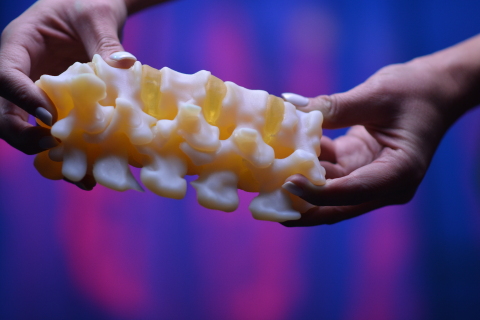Industrial 3D printer manufacturer Stratasys has partnered with digital services firm Ricoh USA to provide point-of-care 3D printed anatomic modeling services to healthcare facilities.
The partnership will see Stratasys’ 3D printing technology integrated into Ricoh USA’s Ricoh 3D for Healthcare workflow in order to increase access to 3D printed medical models for medical facilities and clinicians. The offering aims to remove barriers such as staffing issues, training requirements, and budget constraints for healthcare providers wishing to run a 3D printing facility.
“To date, access to anatomical models at point-of-care locations has been limited to large hospitals and healthcare facilities,” said Gary Turner, Managing Director of Ricoh 3D for Healthcare. “Our cost-effective solution expands access for healthcare providers of all sizes.
“By partnering with Stratasys, through an integration with IBM Watson Health and our ongoing commitment to innovation, we are able to provide these models to any facility using IBM iConnect Access.”

3D printing anatomical models
Anatomical modeling is one of the more established applications of 3D printing in the healthcare sector, with many medical centers and hospitals already running their own in-house 3D printing facilities.
When combined with 3D scanning and X-ray technologies, 3D printed anatomical models can provide a far more accessible and individualized alternative to cadavers, and can also aid surgeons in better preparing for upcoming invasive surgeries and in turn improve treatment success rates.
3D printing technologies can also produce anatomical models with previously unattainable degrees of color fidelity, while saving three to four hours in surgical time and up to £20,000 per operation in some cases.

Stratasys’ anatomical 3D printing capabilities
Anatomical models created by Stratasys’ 3D printing technology have aided healthcare providers in improving their surgical preparedness and allowed medical device manufacturers to conduct testing and train medical professionals on new devices.
The company’s J750 Digital Anatomy 3D Printer is capable of producing biomechanically accurate models that replicate porous bone structures, fibrotic tissue, ligaments, and soft cardiology tissues. The printer leverages three specialized materials developed by Stratasys; TissueMatrix for replicating heart tissue, GelMatrix support material for use inside the model’s cavities, and BoneMatrix for replicating bone structures.
Since its initial launch in 2016, the J750’s capabilities have been directed towards the production of anatomical models, bolstered by the quality and range of colors offered by Stratasys’ PolyJet technology. In 2019, the J750 received validation from global color authority Pantone, which led to Stratasys integrating the standards provider’s color management system into the printer’s workflow. Shortly after, the firm released a medical upgrade to the J750, and released to the public the J750 Digital Anatomy 3D Printer.
In December 2020, Stratasys improved the capabilities of the J750 Digital Anatomy printer further to include biomechanically accurate orthopedic applications such as bones and ligaments.
Stratasys’ technology offering for anatomical models doesn’t end there, with the firm having launched its new, full-color J5 MediJet 3D printer in June this year. The J5 MediJet is designed specifically for medical applications, including patient-specific anatomical models and surgical guides, and is compatible with a wide array of sterilizable and biocompatible 3D printing resins.

The Ricoh 3D for Healthcare platform
Ricoh 3D for Healthcare is an end-to-end workflow created to simplify the design, development, and production of anatomical models. The workflow makes use of the updated IBM iConnect Access diagnostic and medical image exchange platform from IBM Watson Health, the healthcare arm of technology consultancy IBM.
Ricoh USA and IBM Watson Health teamed up earlier this year to integrate the basis of a future 3D printing feature into the platform, which will enable IBM iConnect Access users to 3D print lifelike anatomical models using patient medical imaging data directly from the platform. Through its new partnership with Stratasys, Ricoh USA will use the J750 Digital Anatomy and J5 MediJet 3D printers to create the models produced for its Ricoh 3D for Healthcare platform.
The Ricoh 3D for Healthcare platform is currently available to healthcare providers through two different avenues. The first is a point-of-care option where the Stratasys printers are coupled with Ricoh USA’s managed services staff on-site to manage the entire printing process, in line with the firm’ quality management system and good manufacturing practices.
The second option is an on-demand service whereby providers can order and have anatomical models 3D printed and shipped directly to them. Both options are HIPAA compliant and reportedly easy for medical staff to use.
Through their various partnerships, Stratasys, Ricoh USA and IBM Watson Health are seeking to overcome many of the barriers facing healthcare providers looking to run their own 3D printing facility, such as budget and staffing issues, training requirements, and HIPAA, quality and IT compliance. By overcoming these entry barriers, the partners hope to improve the accessibility of 3D printed, patient-specific anatomical models at the point of care.
“Through our partnership with Ricoh we are giving healthcare institutions the opportunity to access patient care tools that they may not have previously had access to,” said Scott Drikakis, Healthcare Segment Leader for Stratasys. “With Ricoh 3D for Healthcare, providers can easily generate 3D printed models of patient specific anatomy using state of the art technology, through an on-site managed services or on-demand approach.
“This will demonstrate the clinical and economic benefits of anatomic models, while streamlining the historical challenges of establishing 3D printing programs in hospitals.”

Subscribe to the 3D Printing Industry newsletter for the latest news in additive manufacturing. You can also stay connected by following us on Twitter and liking us on Facebook.
Looking for a career in additive manufacturing? Visit 3D Printing Jobs for a selection of roles in the industry.
Subscribe to our YouTube channel for the latest 3D printing video shorts, reviews and webinar replays.
Featured image shows anatomic model of a spine printed on the Stratasys J750 Digital Anatomy Printer. Photo via Business Wire.


